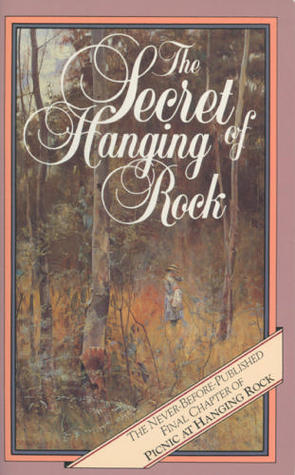 By JOAN LINDSAY (HarperCollins; 1983)
By JOAN LINDSAY (HarperCollins; 1983)
For fans of PICNIC AT HANGING ROCK—both the Peter Weir directed film and Joan Lindsay authored novel—the 54 page SECRET OF HANGING ROCK is an essential read. It consists of the legendary eighteenth chapter of the novel, which was omitted from its publication, and explains (in part) the mystery that powers the story.
Initially published in 1967, PICNIC AT HANGING ROCK tells of three schoolgirls and a teacher who inexplicably disappear during an outing at the titular Hanging Rock formation, located in the Australian outback. One of the girls turns back up with no memory of what happened, and the story ends, after 17 chapters, on an unresolved note, with the two gals and their teacher remaining lost while the school’s repressed headmistress inexplicably goes mad.
Some background on the novel is provided in a prefatory essay by John Taylor, who worked for Joan Lindsay’s publisher. He claims chapter eighteen was excised at the behest of the publisher, but that Lindsay (who died in 1984) definitely wanted it to be published.
The chapter in question, running 12 pages and set down in Lindsay’s rich and erudite prose, is as eerie and esoteric as anyone could possibly hope for. I’m not sure it entirely “solves” the mystery; in fact, it actually deepens it in many respects.
Given that describing the events of chapter 18 would in effect be giving away the ending to PICNIC AT HANGING ROCK I’ll keep my summary vague, revealing only that it involves a flashback of sorts to the girls’ disappearance and a physical transformation that probably would not have transferred too well to film (it also contains prose that was incorporated into an earlier part of the book after chapter eighteen was excised, as pointed out by John Taylor, who claims to have noticed in his initial reading that some elements “didn’t seem to fit”).
The book concludes with a lengthy commentary by Yvonne Rousseau (who previously published a book called THE MURDERS AT HANGING ROCK in which she worked out several possible solutions to the mystery). According to Taylor, Rousseau “makes Sherlock Holmes look like an amateur” in her deductive skills, and brings all those skills to bear on chapter eighteen, providing a learned and detailed analysis that includes references to the aboriginal concept of Dreamtime and the theories of P.D. Ouspensky. Whether Lindsay truly had such things in mind is unknown, but amid all the PICNIC AT HANGING ROCK analyses that have proliferated over the decades Rousseau’s is likely the only one that can truly be called authoritative.
